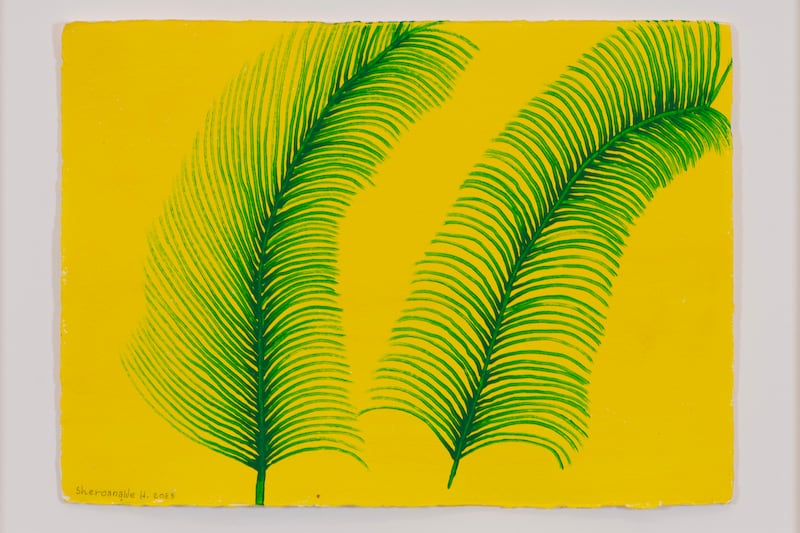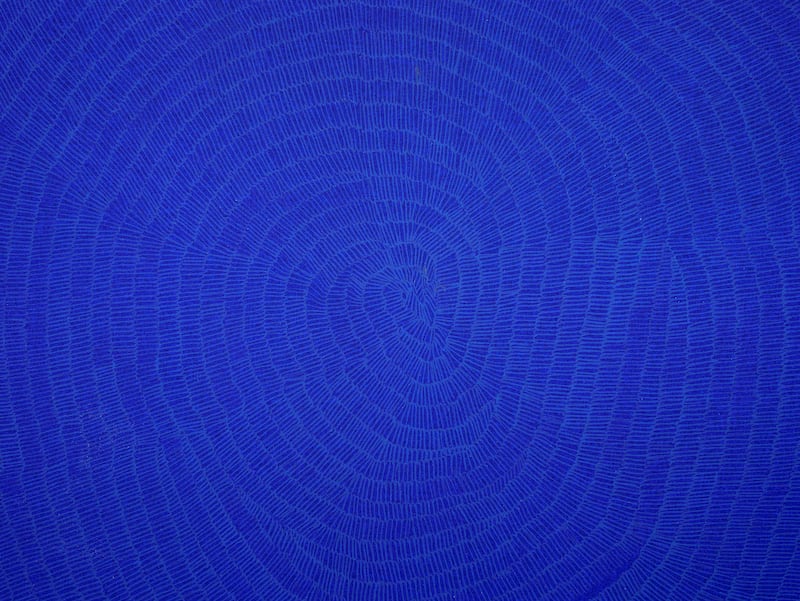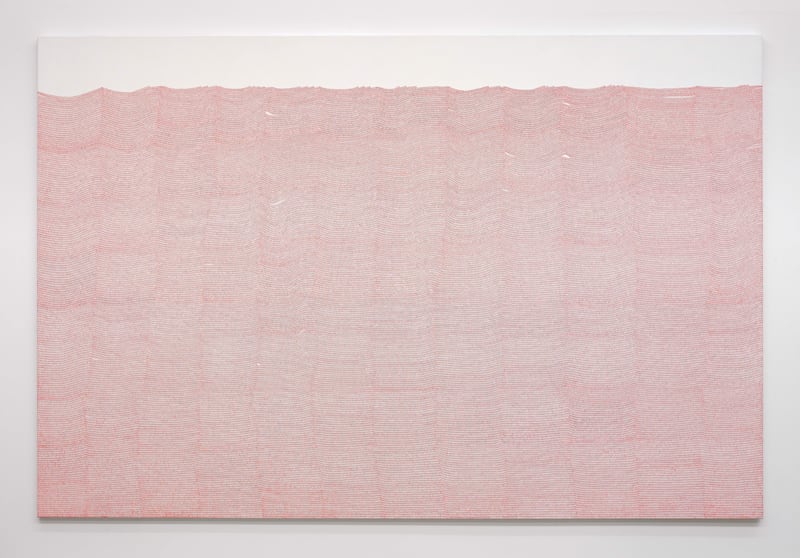“Now, breathe ...” It can seem surprising, given that the phrase opens a million meditations, that we have sometimes to be reminded to inhale. As the general rule of survival has it, we can go three weeks without food, three days without water but just three minutes without oxygen. So, with living and dying at its heart, the question at Take a Breath, the Irish Museum of Modern Art’s lung-filling exhibition exploring “why, how and what we breathe”, should be: Is any artwork not essentially about breathing? “To inspire” also means to breathe, after all.
A freediver would disagree with that three-minute rule of breath and, as art is all about challenging expectations, the exhibition opens with an aquatic installation by the Italian artist Alex Cecchetti. The oceans produce about half the oxygen on Earth. Here, videos made during dives and free dives in the Philippines play over indigo-dyed silk hangings. In the words of the Irish artist and free-diving champion Nina McGowan, who featured in an associated exhibition talk, in the sea “there’s no commodification, no capitalism, no language”. The sea both surrounds and eludes us. Within Cecchetti’s hangings, hammocks invite immersion in the worlds of this fragile and strangely alien ecology. On a recent visit, no museumgoer seemed inclined to dive in.
Wrestling to contain the amorphous, Take a Breath explores its subject via five themes. There is breath as meditation, as language, in warfare; air in a time of environmental catastrophe; and feminism, race and ecology – the latter presented as a tripartite catch-all that tends towards the diffuse. For all that, the breadth of work on show, and the eclectic curation, which avoids the obvious, brings an edgy sensibility, inspiring insight, mostly without choking on its own erudition.

A world as blue as Cecchetti’s follows in the next of Imma’s long corridors, but this time the element is air. Lawrence Abu Hamdan’s Air Conditioning explores through video and an extended wall panel what the Jordan-born, Beirut-based artist terms “atmospheric violence”. Tracking Israeli fighter jets, drones and other unmanned aerial vehicles in Lebanese airspace over a 15-year period, Abu Hamdan accumulated his data from United Nations sources. Made in 2022, and so predating the current conflict in Palestine, it underlines the threatening aural omnipresence of these incursions to those below, while above the plumes wreak their own environmental damages.
READ MORE
The toxic aftermath of war is often lost in relief at a ceasefire – and, as campaigners know, it is hard to emphasise the urgency of things we cannot see. It can seem strange to harp on about the polluting aspects of war when people are being killed with the greater immediacy of physical bombs and bullets, but huge numbers still die. This is emphasised in 2°4′355″N 5°3′23″E, by the Algerian artist Ammar Bouras. Gathering witness testimony, the film documents the lead-up to and aftermath of the Béryl incident of 1962, a French nuclear test near In Ekker, in the Algerian desert, in which underground shafts were improperly sealed. Subsequent studies focused on the French soldiers and officials who were affected by the radiation, but Bouras highlights the voices of the indigenous population whose lands, livelihoods and, often, lives were lost as a result.


Segueing into activism, Forensic Architecture, a group based at Goldsmiths, part of the University of London, show an intensively researched breakdown of the tear gas used during demonstrations against racially based police violence in Portland, Oregon, in 2020. Their video, which tracks tear-gas clouds “in serious excess of recognised safety thresholds”, draws attention to sheer scale of the industry creating highly toxic materials for some organs of state control.
A sequence in Tear Gas Tuesday showing the movements of the gas almost exactly mirrors the Irish artist Joy Gerrard’s Shot Crowd, from 2017, but it is work by John Gerrard, her brother, that is shown here. His real-time 3D projection Dust Storm (Manter, Kansas) 2008 re-creates the Black Sunday dust storm across the central plains of the United States on April 14th, 1935. It feels like a horror film as it inexorably exposes the consequences of misunderstanding the delicate balance between nature and human intervention, and how ultimately puny we are in face of what the world can throw at us.
Similar concerns are more gently evident in a smaller gallery that holds a lovely juxtaposition across time. JMW Turner’s The Lake, Petworth, Sunrise, from 1827-8, shows one of the dramatic vistas for which the painter is so famous. Those magnificent skies were the result not only of the Romantic artist’s genius but also of a series of three huge volcanic eruptions over 20 years, beginning with Tambora, in Indonesia, in 1815. The subsequent ash cloud generated by the largest eruption in recorded history caused “the year without a summer”, during which crops failed and people starved and died. The spectacular sunrises and sunsets continued for more than a decade, as pollution lingered in the atmosphere.
According to the exhibition text that visitors can borrow when they arrive at Imma, “an estimated seven million people die every year from indoor and outdoor air pollution”. In the same space, Yuri Pattison’s Sun[set] Provisioning, a 2019 work, is a guts-out technological installation incorporating an atomic clock, computer systems, sensors and a screen. Pattison, whose work can also currently be seen at the Pumphouse at Dublin Port, has created the system to collect local pollution data and transform it into imagined sunsets. The more pollution, the more extraordinary the colours.
In all this intensity, Take a Breath’s quieter meditative works are a little lost. Patrick Scott’s golden Meditation Paintings are strangely diminished by being shown alongside Maria Hassabi’s golden mirrored benches. The latter are part of a pair of performances that took place in July; without that reference they come across as flotsam from an oligarch’s beach house rather than as a reflection on the meaning of inhalation and expiration. Equally, Waqas Khan’s large-scale minimalist drawings apparently “transcend spatial planes”, but they may need more than a corridor setting to achieve this feat.

The Tambora eruption features in an exhibition timeline of events, a feature at which the curatorial teams at Imma excel these days (last year’s Self-Determination exhibition being a case in point). Well researched and brilliantly clear, it reads like a morality tale of short-sighted hostility and avarice. Beginning with the industrial revolution, it tracks the growth of manufacturing and commerce and their environmental and human consequences. It also covers war and “advances” in chemical weapons of mass destruction, while following the echoes of all in art and literature. Continuing through more war, toxic industrial events and natural disasters, we come to the first UN Earth Day, back in 1970, and the US Clean Air Act. More than a half-century later, the compromises and capitulations drag on.
In 2014 a new thread is introduced to the timeline as “I can’t breathe” becomes the slogan of the Black Lives Matter movement, originating with the last words of Eric Garner, killed by a New York police officer who put him in a chokehold. Respire (Liverpool), a 2023 work by the Austrian-born artist Belinda Kazeem-Kaminski, is a three-screen video showing a series of black people breathing into red balloons. The balloons draw attention to the precarious nature of breath; the installation adds a sense of precious ritual.
That red balloon and its associations with the preciousness of breath call to mind Piero Manzoni’s Artist’s Breath, from 1960 (which is not part of this exhibition). The Italian artist, who charged 200 lire – the equivalent of about €3 today – for every litre of air contained in his red balloons, said, “When I blow up a balloon I am breathing my soul into an object that becomes eternal.” Manzoni died at the age of 30, and today collectors own a ragged red husk, the merest whisper of a once vital life.
There is so much more that is moving, intriguing and (just occasionally) irritating in this exhibition. Marina Abramovic runs out of words, Ana Mendieta moves rocks with her breath, and Sheroanawe Hakihiiwe makes abstracted symbols exploring plants, animals, air and water drawn from his Yanomami heritage, living in the Amazon rainforest on the border between Venezuela and Brazil. Khadija Saye, who died in the Grenfell Tower fire of 2017, is represented by a series of tantalising elusive photographs exploring her Gambian heritage.


Time and space are required to tune out the clamour of artists and artworks addressing the urgent and immediate need to breathe to survive, and those that act as a cry for help on behalf of a poisoned planet, in order to come to terms with the quieter works that nonetheless also reach for the universal. That, in itself, is a measure of the challenge faced by those who care for the future of the planet. In order to survive we must address the crisis, but in order to survive on a daily basis we may also need to mute its noise.
Coming up for air at the end of it all, I am haunted by sadness and by the sounds of Susan Hiller’s extraordinary The Last Silent Movie, from 2007. Sit and be absorbed by a black screen as Hiller tracks lost and endangered languages across the globe. Whispers on the ether, like ghosts across time, some are scratchy field recordings, some have clearly been saved from old language lessons. On-screen translations communicate as the whistles of Silbo Gomero echo across forgotten valleys, reminding someone to bring their castanets to the party. I think of the line from Thomas Kinsella’s Nightwalker about the way “A dying language echoes / Across a century’s silence” and of the vast but generally unacknowledged privilege of simply being able to breathe.
Take a Breath is at the Irish Museum of Modern Art, Dublin, until March 17th, 2025. Yuri Pattison is at the Pumphouse, at Dublin Port, until October 27th


















